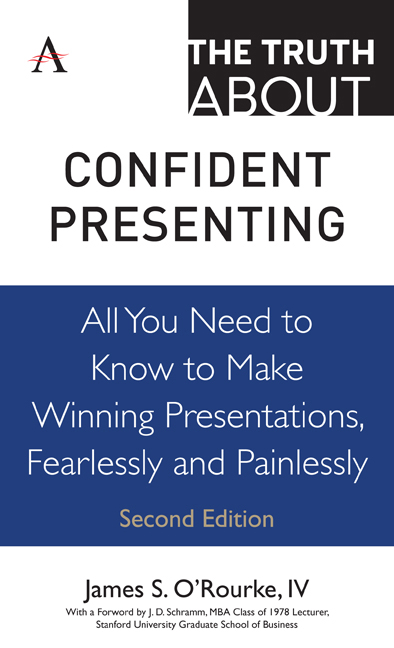 The Truth about Confident Presenting
The Truth about Confident Presenting Book contents
- Frontmatter
- Contents
- Foreword
- Introduction
- Part I Some Initial Truths
- Truth 1 Public speaking is not easy, but it's certainly doable
- Truth 2 The key to success is preparation
- Truth 3 Rehearsal is essential
- Truth 4 Emulating good speakers makes you better
- Truth 5 Establish goals for your presentation
- Truth 6 A presentation is a learning occasion
- Part II The Truth About Getting Ready to Speak
- Part III The Truth About What Makes People Listen
- Part IV The Truth About Developing Support for Your Presentation
- Part V The Truth About Getting Up to Speak
- Part VI The Truth About Managing Anxiety
- Part VII The Truth About Nonverbal Communication
- Part VIII The Truth About Visual Aids
- Part IX The Truth About Handling an Audience
- Part X The Truth About What Makes a Presentation Work
- References
- Acknowledgments
- About the Author
Truth 5 - Establish goals for your presentation
from Part I - Some Initial Truths
- Frontmatter
- Contents
- Foreword
- Introduction
- Part I Some Initial Truths
- Truth 1 Public speaking is not easy, but it's certainly doable
- Truth 2 The key to success is preparation
- Truth 3 Rehearsal is essential
- Truth 4 Emulating good speakers makes you better
- Truth 5 Establish goals for your presentation
- Truth 6 A presentation is a learning occasion
- Part II The Truth About Getting Ready to Speak
- Part III The Truth About What Makes People Listen
- Part IV The Truth About Developing Support for Your Presentation
- Part V The Truth About Getting Up to Speak
- Part VI The Truth About Managing Anxiety
- Part VII The Truth About Nonverbal Communication
- Part VIII The Truth About Visual Aids
- Part IX The Truth About Handling an Audience
- Part X The Truth About What Makes a Presentation Work
- References
- Acknowledgments
- About the Author
Summary
If you're going to ask people to sit through a presentation (or if they are forced to do so by your employer), then you ought to give them one or more good reasons for doing so. Those reasons are almost always directly related to the second of Aristotle's considerations: purpose. Ask yourself, “Why are you speaking, and what can the audience hope to gain from listening to you?”
Let's begin with a review of your goals for the presentation. You don't have any goals? Well, let's back up and think about that first. What do you want from this presentation? Remember, the answer to this question must be related to the needs and interests of your audience. Presumably, you want to help them learn, understand or appreciate something. You may be trying to help them do something in particular. The success of your presentation is best measured against how well the audience understands or appreciates the subject once you finish speaking. Or, perhaps, how well they can do what you've instructed them to do. Remember, if you don't meet your bigpicture goals— your reasons for speaking to a particular group— then the clever organization and eloquent delivery of your talk don't matter at all.
In defining your goals or objective for a speech, the first rule is to “Limit yourself to one sentence.” If you need more than one sentence to state your goal, then you're not clear about your objective. Here's an example: “The objective of this speech is to convince my audience that increased free cash flow will result in a healthier balance sheet.” The objective is nicely focused and reasonably direct. You might have to define a few terms and then explain how it all works, but it does fit into one sentence. The problem, of course, it's not very specific. Here's another example of a goal: “I hope to convince my audience that reducing the age of accounts receivable to 30 days or less will make the company more profitable.” This objective is more specific and lends itself to measurement. Once you explain the terms and show the audience how accounts receivable aging works, you should be able to show the relationship to 5 profitability.
- Type
- Chapter
- Information
- The Truth about Confident PresentingAll You Need To Know To Make Winning Presentations, Fearlessly And Painlessly, pp. 17 - 20Publisher: Anthem PressPrint publication year: 2019


